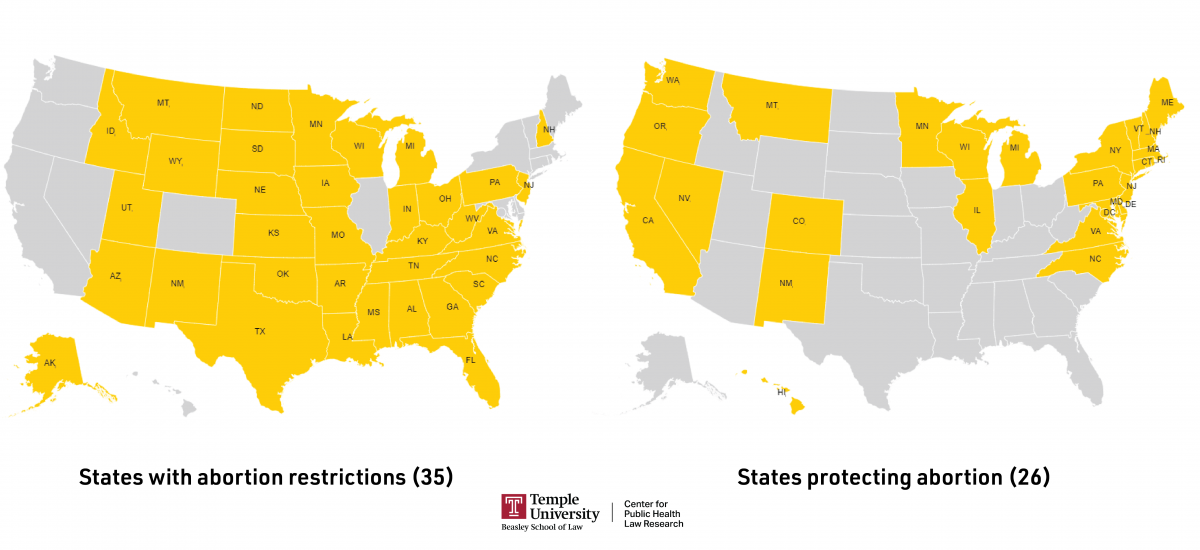Our team was honored to be selected for 11 presentations at the American Public Health Association Annual Meeting this year in Boston. The CPHLR researchers presented on a variety of subjects, spanning the broad range of work we do at the Center each day: opioids and harm reduction, reproductive rights and abortion law, COVID-19 mitigation policies, firearm violence prevention, and strengthening public health authority and workforce capacity. Because not everyone has the privilege of attending APHA, we're bringing some of our presentations to you in a few installments.
While we’re focusing here on our presentations on laws and policies related to sexual and reproductive health, you can read the first post on firearms and intimate partner violence here.
Adrienne Ghorashi and CPHLR Fellow Patty Skuster shared three presentations reviewing the Center’s work on US and global abortion laws. Adrienne is currently a Governing Councilor for the Sexual and Reproductive Health Section and became Co-Chair of the Abortion Task Force during the meeting.
Global Abortion
Patty discussed potential methods and indicators for measuring implementation of abortion law and policy. For example, in order to implement abortion law governments must train and equip abortion providers, including mid-level providers, where permitted by law. In addition, as another example, officials must ensure abortion is included in any national healthcare financing programs or national insurance schemes. CPHLR researchers are considering questions such as which steps are key for implementation? To what extent should we consider steps for implementation that reflect abortion services for particular social groups? How can implementation metrics account for disaggregated data?
Adrienne also participated in the same roundtable discussion. She discussed how CPHLR researchers aim to measure how well individual countries adhere to evidence-based policy recommendations on abortion by combining legal epidemiology methods with global public health and human rights expertise.
Shifts in the post-Dobbs legal landscape: Tracking and evaluating state laws that impact abortion service delivery
Adrienne presented on new data published just before the conference that tracks the drastic changes in abortion legislation after the US Supreme Court decision on June 24, 2022, overturning Roe v. Wade, overruling nearly 50 years of precedent protecting the right to pre-viability abortions.
When the Dobbs decision was announced, providers, patients, and advocates were left in uncertainty. “Trigger laws” banning abortion that were contingent on the overturning of Roe and “pre-Roe” abortion bans suddenly became legally enforceable.
While some states moved quickly to ban abortion, others have strengthened protections for abortion as a response to Dobbs. New “shield laws” attempt to limit the liability of abortion providers and patients who travel to another state to receive care that is increasingly becoming criminalized.
This dataset provides a high-level overview of state abortion restrictions and protections enacted post-Dobbs, tracking key legal developments from June 1, 2022, through August 31, 2022. The dataset was conceptualized by Temple University’s Center for Public Health Law Research and the Society of Family Planning to serve as a resource for researchers seeking to better understand the impact of the Dobbs decision, and is a companion resource to the Society of Family Planning's #WeCount project.
Using sentinel surveillance methods, a type of scientific legal mapping, to collect and code key features of the abortion law and changes over time. The dataset covers legal developments from June 1, 2022, through August 31, 2022, (updated periodically over one year) and includes state statutes, regulations, court opinions, attorney general opinions, and executive orders in all 50 states and DC.

Sign up for our newsletter for first access to the upcoming 2023 update to the dataset further tracking movements of the law once it’s available.
